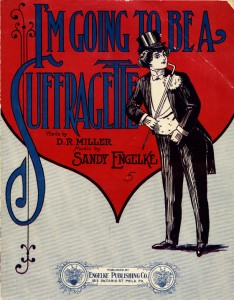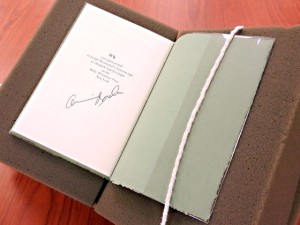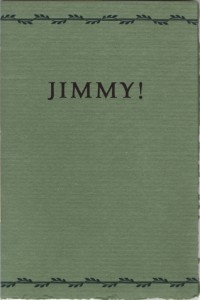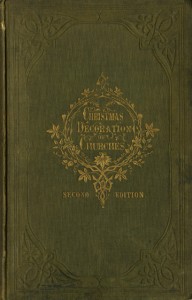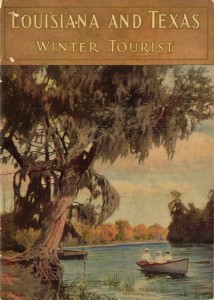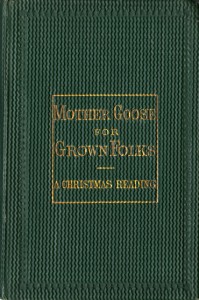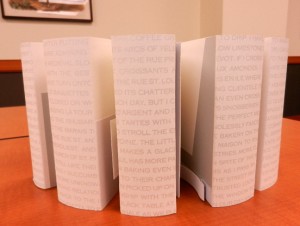
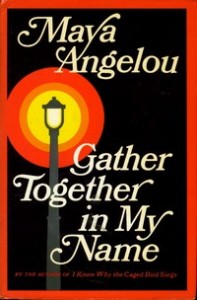
cover of “Gather Together in My Name,” by Maya Angelou (1974)
After a long battle with illness, Maya Angelou has died in her Winston-Salem, North Carolina home. The “lyrical witness of the Jim Crow South,” defied definitions throughout her life and reached the apex of her popularity and cultural presence when she delivered the inaugural poem of Bill Clinton’s presidency, “On the Pulse of the Morning.” Her most lasting and iconic literary legacy, however, is almost certainly captured in, “I Know Why the Caged Bird Sings.” A pioneering work of “autobiographical fiction,” trumpeting the voice of the previously unheralded female, southern, African-American, it was a critical and commercial literary success upon its publication in 1969.
Born Marguerite Ann Johnson, April 4, 1928, she would change her name to Maya Angelou in the 1950s while performing calypso at The Purple Onion nightclub in San Francisco. Dance and song were mere branches of a creative and artistic life that was evidence of a broad talent, emerging not only as poetry and prose in her lifetime, but also in opera, film, and civil rights activism (just to name a few). Recounting the winding narrative of her life, she would publish a series of autobiographical works, beginning with “Caged Bird,” that documented the twists and turns that blazed as a crucible of neglect and sexual abuse, leading her to the depths of crime and poverty. No surprise in retrospect, but in 1969 it no doubt raised eyebrows that this work resonated with so many and testified with such authority.
The University of Houston Special Collections holds a first edition of what might be considered a sequel to “I Know Why the Caged Bird Sings.” “Gather Together in My Name,” picks up where “Caged Bird” leaves off as “the poet, still in her teens, gives birth to a son, tries to keep a job, falls in love, dances, falls out of love, chases after her kidnapped baby, and goes to work in a house of prostitution thinking she is helping the man she loves.” Or, as Gary Younge writes, “To know her life story is to simultaneously wonder what on earth you have been doing with your own life and feel glad that you didn’t have to go through half the things she has.”
As we remember Maya Angelou, we invite you to the Special Collections Reading Room to study this work or any of Angelou’s other works in our holdings. We wish her a lasting peace, assured that what she placed on paper and singed into our psyche will make certain her lasting legacy.
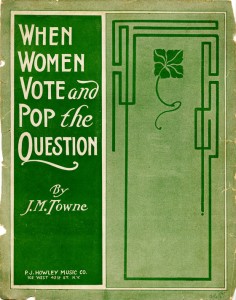
cover of “When Women Vote and Pop the Question,” available for study in the University of Houston Special Collections Reading Room
A new exhibition opened over the weekend in the Texas State Capitol. Citizens at Last: The Woman Suffrage Movement in Texas, documents the struggle for women’s suffrage and the unique history of the movement in the state of Texas during the nearly three decades of struggle that immediately preceded the ratification of the Nineteenth Amendment in 1920.
The exhibit, presented by Humanities Texas, runs through Saturday, May 24th and documents not only the development of the movement to extend equality across the genders, but also those who battled against this progress. The anti-suffragist movement came to manifest itself in a number of ways. Some were deceptively raw (these examples of anti-suffragist postcards and visual art are likely to have you alternating between sporadic wincing and baffled laughter) while others, in retrospect, seem downright bizarrely sublime.
Suffragist sheet music has been fairly well-documented. However, a closer study with a wider sampling of the sheet music produced during that time may may serve to expand our understanding of the role of art and, specifically, music in the midst of political strife. Those fighting for the right to vote for women penned iconic anthems like “Give Us the Ballot” and “Under Fire: March and Two Step” (often sold as a fundraising tool for “Political Equality Clubs”). Anti-suffragist groups sought to co-opt the popularity of this new genre by introducing some parlor music of their own.
I present to you, the musical genre of anti-suffragist sheet music!
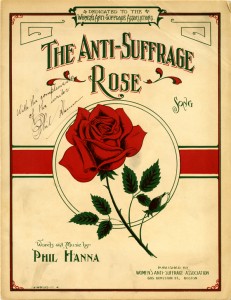
The Anti-Suffrage Rose, “Inscribed on the cover in a beautiful hand by Hanna. Dedicated to the Women’s Anti-Suffrage Association.”
The anti-suffragists sought to fight music with “music,” crafting songs that championed the bravery and struggle of anti-suffragist groups. One of the most famous of these, Phil Hanna’s “The Anti-Suffrage Rose” (the anti-suffragists, it seems, embraced the red or pink rose as the flower of choice to represent their cause, while suffragettes avoided roses and instead embraced jonquils or sunflowers as their emblematic blooms) was dedicated to the Women’s Anti-Suffrage Associations and the lyrics attempted to buoy the spirits of these women in their fight, reading, “Lovely Anti-Suffrage Rose. / You’re the flow’r that’s best of all! / You’re better far, than jonquils are, / We are going to prove it in the Fall.”
Others took up the suffragist anthems and penned songs of more subtle parody and condescension. An example of this includes D.R. Miller’s lyrics for “I’m Going To Be A Suffragette” where a perplexed husband laments and ridicules his wife’s new political interest while she clamors on in the refrain, “I’m goin’ to be a suffragette, Billy / Hear me shout Hurray, Hurray. / Now don’t you think that I am silly / or will waste my time away. / The sex that always joggled the cradle / have got some rights you bet. / I say Hip Hip Hip Hip Hip Hurray / I’m goin’ to be a suffragette.”
While the University of Houston’s Music Library is definitely the destination to visit on campus if you are serious about your research of musical scores, it is not uncommon for Special Collections to be approached by researchers desiring access to our surprisingly rich reservoir of historically significant sheet music, including the anti-suffragist songs described above. You will not want to miss J.M. Towne’s “When Women Vote and Pop the Question” which has us all wondering in song if we are ready for a bleak and horrible future where, “Men will play second fiddle, / Stay at home and grease the griddle, / While the women buy the shirts.” If you are interested in glancing an alternative political atmosphere where the public debates are not framed by the much-maligned “political correctness” of our current day, we invite you to visit us and take a closer look at these confounding relics from our not-so-distant past. Suddenly thinking before speaking, or writing songs, may not seem like such a burden to carry.
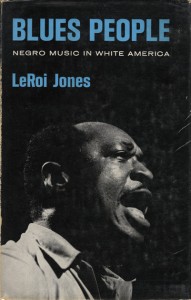
Cover of Blues People by LeRoi Jones (Amiri Baraka)
Poet, playwright, and the generally prolific and polarizing Amiri Baraka passed away in his hometown of Newark, NJ on January 9th, 2014.
Standing at the early vanguard of the Beat Generation, Amiri Baraka (then LeRoi Jones) settled in Greenwich Village in the 1950s, striking up early dialogues with Beat luminaries like Allen Ginsberg. In the early 1960s he published Blues People: Negro Music in White America and won an Obie Award for his controversial play, Dutchman. Issues of race and divergent political leanings often found themselves boiling to the top of his writings, but it was the 1965 assassination of Black Nationalist Malcolm X that served as the crucible of radicalization for the Amiri Baraka that would emerge from the violence of the 1960s. Literally and symbolically leaving The Village for Harlem, and as more and more progressive leaders like Martin Luther King, Jr. and Robert Kennedy found themselves felled by assassins’ bullets, a poetry of radical self-defense began to ring out from Baraka and the hundred blocks.
But, for Baraka, this was not a method and manner of simply courting controversy. It was a necessity to his writing. In a 1986 interview with Terri Gross, discussing the hard edges of race and violence that have defined himself and his family, themes that thereby push themselves to the forefront of his writings, Baraka states, “To talk about those things in America is to be radical. Just to talk about them.”
Baraka’s greatest controversy may have come in the wake of the 9/11 terrorist attacks, while he was Poet Laureate of New Jersey and penned “Somebody Blew Up America.” Lines dripping with anti-imperialist rhetoric, that even elicited accusations of anti-Semitism, did not sit well with New Jersey Governor James McGreevey. Failed attempts to remove Baraka from the post of Poet Laureate finally resulted in the state’s legislature abolishing the position outright, only four years after establishing it, rather than allow Baraka to retain the title.
Here at the University of Houston Special Collections we celebrate the writing and life of Baraka with a handful of items representing his literary legacy. Of particular note is a copy of his breakthrough Blues People as well as a signed copy of “Jimmy,” the eulogy Baraka gave at the funeral of James Baldwin (#119 of 150 copies printed to mark the occasion) back in 1987.
Baraka’s funeral will be held in his hometown of Newark on January 18th. He was 79 years old.
‘Tis the season!
If the bombardment of advertising and well-wishers has you exclaiming, “Bah! Humbug!” and you just can’t seem to get in the holiday mood, digging through our catalog might unearth a few items to put you in the spirit of the season.
Reverend Edward L. Cutts gives us An Essay on the Christmas Decoration of Churches, a second edition of an 1863 imprint which begins by lamenting the passing of the good ol’ days. The “Introduction” reads, “In old times men took more pains to do honour to the great events of life than we do now. They would strew the street-way with rushes and flowers, and hang tapestries from every window, when any procession of king, or lord, or civic pageant was to pass through their streets.”
These kids today, they just don’t know how to decorate!
He goes on to broadly and briefly trace the traditions of Christmas and other holiday decorations before providing a litany of detailed best practices in the decking out of one’s church for the festive holiday season. Recommendations include the use of holly as a staple for your decorations (“It is specially appropriate, by custom and association, to Christmas, as the blooming sallow is to Palm Sunday, or milk-white hawthorn to May-day.”), the correct manner of application of a spiral wreath to a pillar (“Take care that the wreath is not put upside down; foliage must never be put in a direction contrary to that of its growth.”), and what exactly to do with the pews (“We recommend that the pews and benches should be left undecorated; but if it is desired to put some holly about them out of respect to long-established custom and honest prejudices, let it not be done with the great straggling boughs, but with small handsome sprigs, all of about the same size.”).
Done with decorations and thinking of travel this season? Louisiana and Texas for the Winter Tourist, published in 1911, represents the Southern Pacific Railroad Company’s targeted marketing to all those snowbirds desperate for warmer climes in the winter months. Tourists in the early 1900s were sold a city in Houston that was “the metropolis of the whole imperial domain of the Lone Star State… a great and beautiful city,” promised golf 365 days a year, and touted grand hotels, like the New Bender, the Macatee, the Bristol, and the Brazos.
Finally, when you are ready to settle down for that long winter’s nap, why not take a gander at Mother Goose for Grown Folks: A Christmas Reading (1860). We are reintroduced to that “laughing oracle” of Mother Goose, who reminds us, “Of morals in novels, we’ve had not a few;/With now and then novel moralities too…” What follows throughout are “grownup” retorts to the old and familiar Jack Horner (plucking plums from “the fruit of others’ baking”), a “portly old Dame… Britannia by name” living in a shoe who seems to be having some problems with one of her children (a young upstart named Sam, who refuses to take his tea), and the problematic Humpty Dumpty, who teaches us many lessons but none more valuable than the following:
So the great scheme works on, –though, like eggs from the wall
Little single designs to such ruin may fall,
That not all the world’s might, of its horses or men,
Could set their crushed hopes at the summit again.
Here is hoping your hopes are not crushed or, if so, that they are indeed being repaired back towards the summit again as we head towards the new year. The University of Houston Special Collections wishes you and yours all of the best throughout this holiday season.
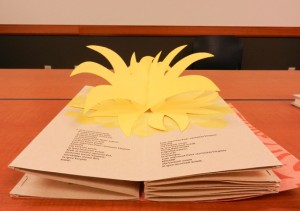
Sanctae Hildegardis Circulus Sapientiae =: Circle of Wisdom by Claire Van Vliet and others for Janus Press.
Among our visitors to Special Collections are students from the School of Art, who are particularly interested in the design and structure of books. These students enjoy exploring our collections of fine press books and artists’ books.
Fine press books are created with a strong emphasis on design and materials. They often involve a collaboration between a writer, printer, and visual artist. The books are usually printed on handmade paper with a carefully selected typeface using an old-fashioned letterpress printer. Visual harmony exists between the text, the illustrations, and the binding. Fine press books are highly sought by collectors and libraries.
Artists’ books explore the line between a book and a work of art. Less traditional than fine press books, they often have unusual bindings resembling structures such as an accordion, a tunnel, or a star. Although they are usually made from paper, artists’ books may be constructed with wood, plastic, or even rock. Artists’ books are often as whimsical as they are beautiful, and may be found in libraries, museums, and private collections.
Both fine press books and artists’ books are usually published in small runs by independent presses.
Special Collections holds numerous books from the following fine press printers. These books can be located in the UH Libraries’ catalog by typing the name of the press in the Author field or following the links below.
Artists’ books may be located in the UH Libraries’ catalog by entering the subject heading Artists’ books. The subgenre known as pop-up books may be located by entering the subject heading Toy and movable books — Specimens.
Special Collections is particularly strong in artists’ books from the following presses and artists’ collectives.
Peter & Donna Thomas or Thomas Peter (Peter R.)
Art students or those who are simply curious may wish to view artists’ books by structure. Special Collections holds the following examples of particular book structures:
Accordion Binding
Barton, Carol J. Loom. Bethesda, Md.?: Carol June Barton?, 1989.
King, Ronald. Hick, Hack, Hock. London: Circle Press, 1995.
Rowe, Sandra. Snake. Rosendale, N.Y.: Women’s Studio Workshop, 1991.
Pop-Up Book
Hildegard, Vliet C. Van, Katie MacGregor, Robert Mealy, and Na’ama Lion. Sanctae Hildegardis Circulus Sapientiae =: Circle of Wisdom. Newark, Vt: Janus Press, 2001.
Tunnel Book
Barton, Carol J. Tunnel Map. Bethesda, Md: C.J. Barton, 1988.
Sculptural Book
Hom, Mei-ling. In the Morning. Rosendale, N.Y: Women’s Studio Workshop, 1990.
Jacob’s Ladder
Morrison, Lois. Water/fish. Rosendale, N.Y.: Women’s Studio Workshop, 1988.
Please visit us in Special Collections the next time you’re feeling arty!
